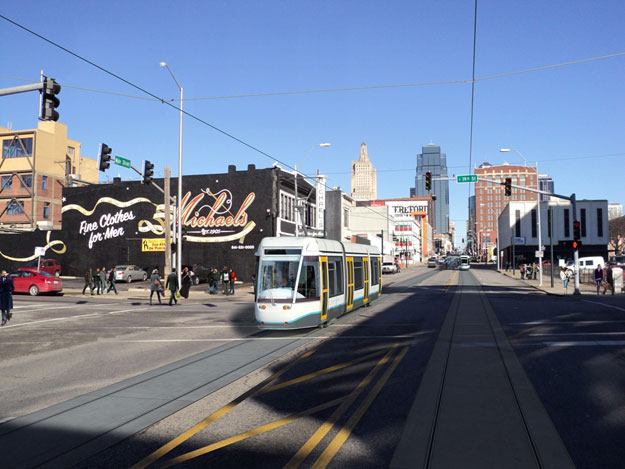
This is the first of a two-part article on civic and business leadership for transit in Missouri cities.

Artist’s rendering of the Kansas City streetcar. image source: Office of Kansas City Mayor Sly James.
Leaders on the eastern and western borders of Missouri are trying to prove that St. Louis and Kansas City can again be the “Show Me” state by trying new approaches to local transit planning and finance. In both cities, citizen-led and business-backed civic groups have pushed for the installation of short-distance transit circulators, and in both cases, they chose streetcars, as part of a business growth and real estate development strategy. Interestingly, in both cases the proposals came from residents and businesses, initially without the support of the existing transit agency. It’s fascinating to see the citizens appear to be ahead of the government agencies, who after some ambivalence haltingly scurry to catch up.
Part I: Kaycee Shows the Way
In Kansas City, David Johnson lives and works downtown, a core area that has languished as the whole region sprawled outward over the past several decades. Now he is president of the civic organization Streetcar Neighbors, the main force behind a streetcar proposal that has gone from concept to construction in an astonishingly short time and with remarkably little controversy.
David and his allies were able to use a Missouri state law that allows the creation of a local taxing district which can be extremely local – in this case, a district big enough to encompass the territory along the corridor stretching just over three kilometers through the downtown from a popular public market to the Crown Center, an entertainment and hotel complex near the historic railway station. (Although downtown Kansas City has been stagnant for years, it does have some mammoth single-use facilities like a convention center, performing arts halls, and one of those ersatz “entertainment districts” designed to look like what vibrant used to look like naturally.)
This small district, with a relative handful of residents but proportionally high assessed property tax valuation and sales tax generation, is certainly a fiscal anomaly in its ratio of voters to valuation, so the model has very limited replicability. But in this case it worked. The vote passed in 2012.
Remarkably, construction started in 2013 and the line, with 18 stops, is to open in 2015. David and his allies formed the Kansas City Streetcar Authority, a special purpose unit of government, which has overseen the work. Subsequently, the existing transit agency, the Kansas City Transportation Authority (KCATA) has come on board as the technical adviser for the project. KCATA is also improving its bus service, with two “bus rapid transit lite” lines having recently been added to their system, featuring some though not all of the features of BRT like improved shelters, frequency, and speed. What seems like growing cooperation between the KCATA and the activists who sponsored the streetcar is an important positive development, signaling that the streetcar will be treated as real transit (for example, with schedules and transfers timed to connect with intersecting bus lines) rather than as a singular toy.
Yesterday, I had the pleasure of walking the streetcar route with David Johnson, whose vision of downtown Kansas City vastly exceeds the under-utilized buildings and surface parking lots that pock the district today. Even as David envisions that somewhat abstract future, he also has an eye for today, greeting many of the merchants along the street by name and talking knowledgeably about their current business, since he’s almost literally the guy next door. He’s got both long-range perception and appreciation for the fine-grained details of today’s residents that a planner should have.
I think his ambitions for better urban mobility extend well beyond that little three kilometer stretch of downtown Kaycee – because when we got near Union Station he involuntarily started musing about the importance of Missouri needing better passenger trains between Kansas City and………St. Louis.
 On the Brink: Will WMATA’s Progress Be Erased by 2024?
On the Brink: Will WMATA’s Progress Be Erased by 2024?
The experience of being a WMATA rider has substantially improved over the last 18 months, thanks to changes the agency has made like adding off-peak service and simplifying fares. Things are about to get even better with the launch of all-door boarding later this fall, overnight bus service on some lines starting in December, and an ambitious plan to redesign the Metrobus network. But all of this could go away by July 1, 2024.
Read More A Bus Agenda for New York City Mayor Eric Adams
A Bus Agenda for New York City Mayor Eric Adams
To create the “state-of-the-art bus transit system” of his campaign platform, Mayor Adams will have to both expand the quantity and improve the quality of bus lanes. We recommend these strategies to get it done.
Read More